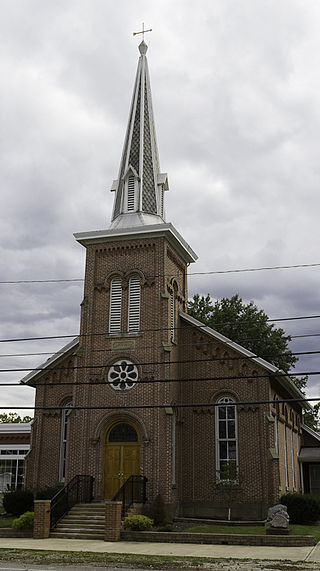
The former Nast Trinity United Methodist Church, now known as The Warehouse Church, is a historic congregation of the United Methodist Church in Cincinnati, Ohio, United States. Designed by leading Cincinnati architect Samuel Hannaford and completed in 1880, it was the home of the first German Methodist church to be established anywhere in the world, and it was declared a historic site in the late twentieth century.
Holy Trinity Greek Orthodox Church may refer to:

The Second Baptist Church in Poughkeepsie, New York, United States, is located at the corner of Vassar and Mill streets. It is a wooden building from the late 1830s in the Greek Revival architectural style, the only remaining church in the city in that style.

The Cake Theater is a historic building on Veterans Square in Laconia, New Hampshire, United States. Built in 1836 and extensively restyled in 1871, it is a fine 19th-century building, illustrating adaptive alterations made over time to reflect changing uses and tastes. The building was listed on the National Register of Historic Places in 1985.[1]

The First Congregational Church is a historic church in Orwell, Vermont. The current meeting house was built in 1843, and is one of state's best examples of Greek Revival ecclesiastical architecture. It was listed on the National Register of Historic Places in 2001.

The Mechanicsburg Baptist Church is a historic church in the village of Mechanicsburg, Ohio, United States. Constructed for a Methodist congregation in the late nineteenth century, the building was taken over by Baptists after the original occupants vacated it, and it has been named a historic site.

St. Michael's Catholic Church is a historic Catholic church in Mechanicsburg, a village in Champaign County, Ohio, United States. Completed in the 1880s, it served a group of Catholics who had already been meeting together for nearly thirty years. One of several historic churches in the village, it has been designated a historic site because of its well-preserved nineteenth-century architecture.

St. Paul's African Methodist Episcopal Church is a historic church in Urbana, Ohio, United States. Built in the Greek Revival style in 1876, it is home to a congregation that was founded in the mid-1820s.

Mechanicsburg United Methodist Church is a historic Methodist congregation in the village of Mechanicsburg, Ohio, United States. Founded in the early nineteenth century, it is the oldest church in the village, and as such it has played a part in the histories of other Mechanicsburg churches. Its fifth and present church, a Gothic Revival-style structure erected in the 1890s, has been named a historic site.

First United Methodist Church is a historic congregation of the United Methodist Church in downtown London, Ohio, United States. Founded in London's earliest years, the congregation worships in a historic church building that was built in the 1890s.

Trinity United Methodist Church is located in Des Moines, Iowa, United States. It was listed on the National Register of Historic Places in 1998 as Trinity Methodist Episcopal Church, which was its previous name.

First United Methodist Church is a historic Methodist church at Fort and N. Adams Streets in Buffalo, Wyoming, United States. The church was built in 1899, and was added to the National Register of Historic Places in 1976 as the Methodist Episcopal Church. It is located at the corner of Adams Avenue and Fort Street in Buffalo, Wyoming.

The York United Methodist Church is a United Methodist congregation in Medina County, Ohio, United States. Formed during the middle of the 19th century, it worships in a prominent church building that has been named a historic site.

St. Henry's Catholic Church is a historic Catholic parish in the rural community of Harriettsville in the southeastern part of the U.S. state of Ohio. Established for German settlers in the 1860s, it worships in a landmark church building constructed in the 1890s. As the only stone building in the area and the work of a prominent architect, it has been named a historic site.

Immaculate Conception Catholic Church is a historic Catholic parish at Fulda in rural Noble County, Ohio, United States. Established in the 1840s among a group of German immigrants, it worships in a landmark building that dominates the surrounding community. The building has been named a historic site.

Trinity Lutheran Church is a historic former Lutheran church in downtown Canton, Ohio, United States. Built in the 1880s for a flourishing congregation, it closed in the early 2010s, leaving behind a church building that has been named a historic site.

Albert Street Uniting Church is a heritage-listed Uniting church at 319 Albert Street, Brisbane City, City of Brisbane, Queensland, Australia. It was designed by George Henry Male Addison and built from 1888 to 1889 by Thomas Pearson & Sons. It was originally known as Albert Street Methodist Church and Central Methodist Mission. It was added to the Queensland Heritage Register on 21 October 1992.

Trinity United Methodist Church is a historic United Methodist church located in downtown Evansville, Indiana. The congregation began in 1825 as a Methodist class and its Gothic Revival style brick church building was completed in 1866. It was listed on the National Register of Historic Places in 1982.



















